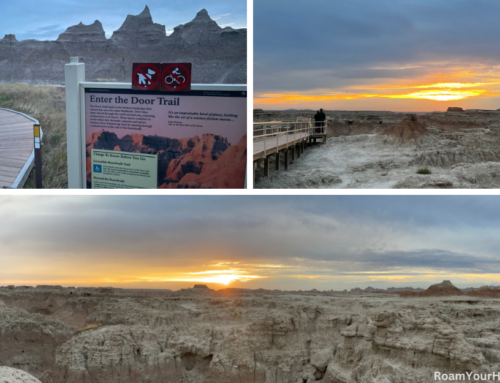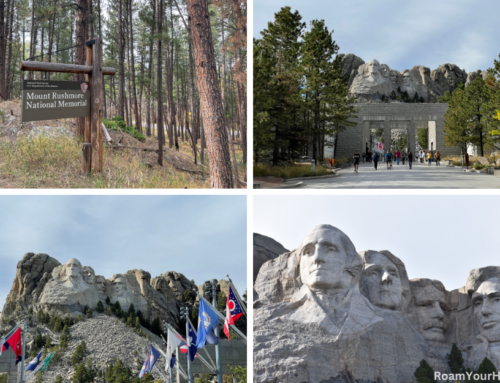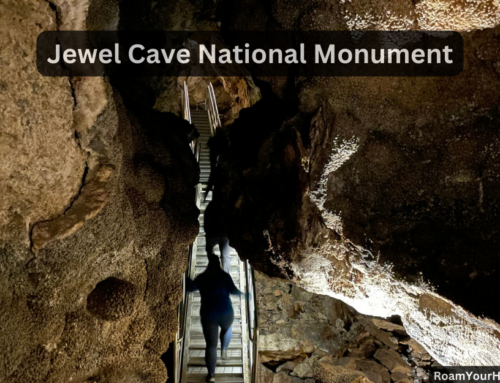
Wind Cave National Park: Natural Entrance Tour
We pulled into Wind Cave National Park late on a fall afternoon. It was going to get dark soon, so we got to Elk Mountain Campground and pitched the tent. It was off-season, so it was half-price and first come, first served. We were on a road trip through the Black Hills of South Dakota and booked cave tours for the following morning.
“Wake up! Let’s catch the sunrise!” I said to a very sleepy wife well before the sun came up. “Okay, okay, give me five more minutes, then I’ll be good to go,” she responded, half awake. I got up and started making coffee and breakfast. Fifteen minutes later, she joined, ready to go for the day.
Our first tour was at 9 am, so we wanted to use the early morning sun to explore above ground and hopefully see some wildlife. Pulling into the campground last night, we met a particularly handsome bison getting a good scratch on the entrance sign.
Sunrise in Wind Cave National Park
After breakfast and breaking camp, we get on the road quickly, hoping to see some wildlife. We saw more bison and a few birds here and there, but the sunrise was the highlight. A cool misty fog clung to tan prairie dotted with ponderosa pine, while the sun warmed the sky with a beautiful display of fleeting yellow, orange, pink, and purple clouds. “Just wow! This is so pretty!” My wife said to me while sipping coffee and taking in the incredible view.
After an enjoyable morning, we went to the visitor center to prepare for part two of the day: exploring the depths of Wind Cave.
Wind Cave National Park was established in 1903 to protect the intricate cave formations. It’s not the longest cave in the world—it’s the 7th longest—and it’s not even the longest cave in South Dakota. Nearby Jewel Cave National Monument is longer and heads up, it’s well worth a tour. We did it the day before. Wind Cave is considered the densest cave system in the world, meaning it has the greatest number of passage volume per cubic mile.
Our first tour was the Garden of Eden Tour. The short quarter-mile loop of the upper chamber gives an excellent introduction to the cave. It’s perfect if you are short on time. You can read about our experience on the Garden of Eden Tour here.

Wind Cave’s Natural Entrance Tour
After the first tour, we grabbed a quick snack in the car and returned to the VC for tour number two, the Natural Entrance Tour.
As we gathered to start, our tour guide ranger reminded us not to touch the inside of the cave, to stay together, and, of course, to ask questions and have fun.
After a short walk, we came to our first stop, the actual natural entrance of Wind Cave.
“Wind Cave is considered one of the best examples of a breathing cave. This means the cave “breathes” in or out, depending on atmospheric pressure inside and outside of the cave.” The ranger explained. “If the air pressure outside the cave is higher than that inside the cave, air blows into the cave. If it’s lower outside than inside, air blows out of the cave. If the air pressures are at equilibrium, there is no airflow.”
Scared Place to Native Americans
She explained that Wind Cave is considered sacred by many Native American tribes, particularly the Lakota of the Black Hills, who hold the cave center to their Emergence Story.
This tour does not enter the cave through the natural entrance but through another seal of the man-made entrance. It was two-thirds of a mile long and expected to last an hour and fifteen minutes. It’s a point to point we would exit through the same elevator we had taken earlier.
As we entered the cave, it cooled down immediately. Wind Cave stays a chilly 54 degrees year-round. We started our journey through the middle of the cave. This tour passes by many named areas, such as the Post Office, Sampsons Palace, Queens Drawing Room, and Giant Stones Quarry.
Boxwork, Wind Cave’s signature formation, is abundant on this tour. The ranger explained that more than 95 percent of the world’s known boxwork formations are found in Wind Cave. There were many stunning displays of boxwork along the way. “It kind of looks like a honeycomb,” my wife remarked.
The ranger did a great job explaining other formations as we passed by. “Look to the left,” she said to the group. “This is frostwork. Frostwork forms when air interacts with droplets of mineral-rich water. It’s formed from a mineral known as aragonite. As you can see, its crystals form delicate branches of needles or frost-like structures. Some Wind Cave frostwork has grown 8-10” tall crystals resembling frosted Christmas trees!”
As we came to the elevator to exit the cave, I was once again thoroughly impressed.
If you are in the Black Hills, I can’t recommend making time for Wind Cave National Park.
How long does it take to visit Wind Cave National Park?
Expect to spend at least half a day, but if you have the time, a full day would be better.
Where to stay in Wind Cave National Park?
Elk Mountain Campground is located in the park. It is quite scenic and bridges the line of ponderosa pine forest and open prairie. Reservations are required during peak season, and otherwise, it is first come, first served.
How to get to Wind Cave National Park
From Rapid City:
- Take South Dakota Highway 79 south, approximately 50 miles to U.S. Highway 385.
- Turn right onto U.S. Highway 385 North, then go through Hot Springs.
- Take U.S. Highway 385 for another 6 miles north into Wind Cave National Park.
- Follow signs to the visitor center.
From Rapid City via the Black Hills:
- Take U.S. Highway 16 south and west to U.S. Highway 385.
- Turn left on U.S. Highway 385 south to Hill City and continue south through Custer City.
- Wind Cave is located about 20 miles south of Custer, South Dakota, off U.S. Highway 385.
- Follow signs to the visitor center.
From western Nebraska:
- Follow U.S. Highway 385 north through Hot Springs, South Dakota, to the park.
- Follow signs to the visitor center.
From Custer State Park:
- Follow South Dakota Highway 87 south into Wind Cave National Park.
- Follow signs to the visitor center.
Other things to do near Wind Cave
Visit Mount Rushmore National Memorial.
Explore Jewel Cave National Monument.
Discover the beautiful and historic Bear Butte State Park.





